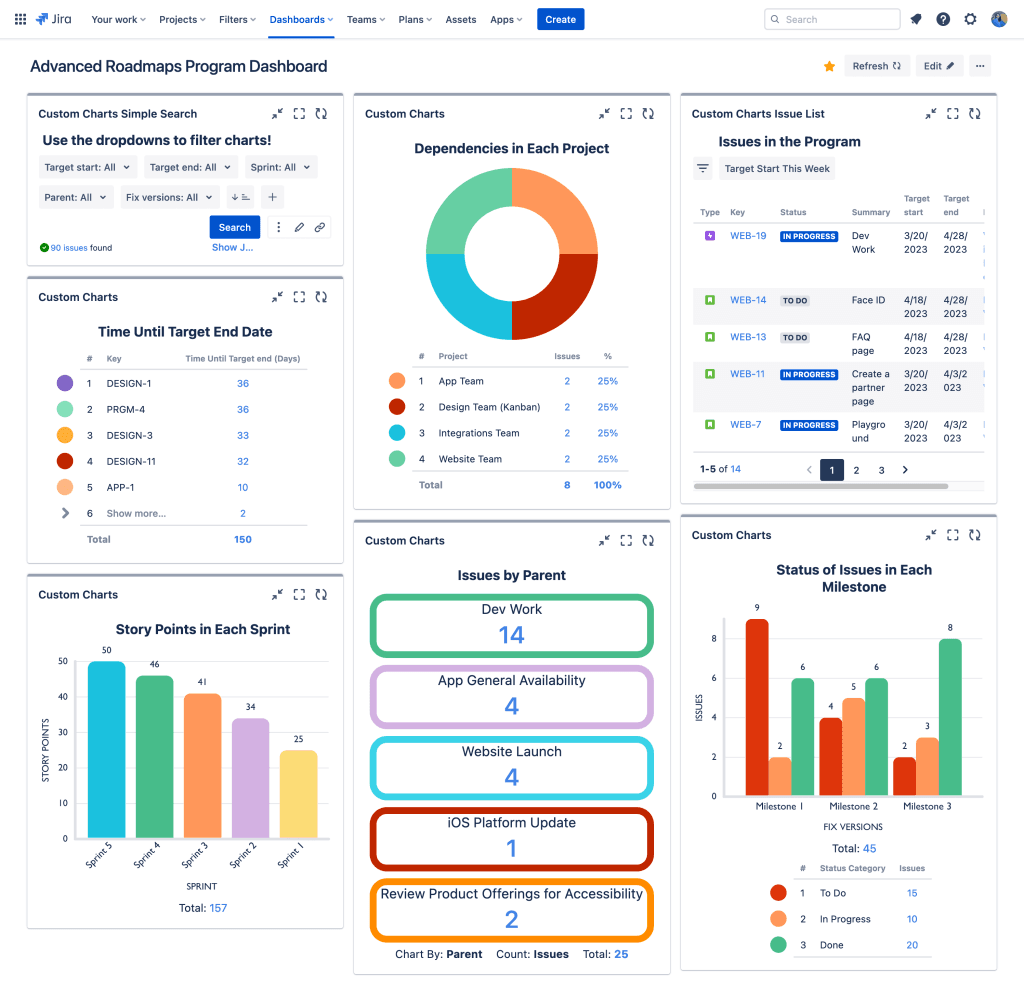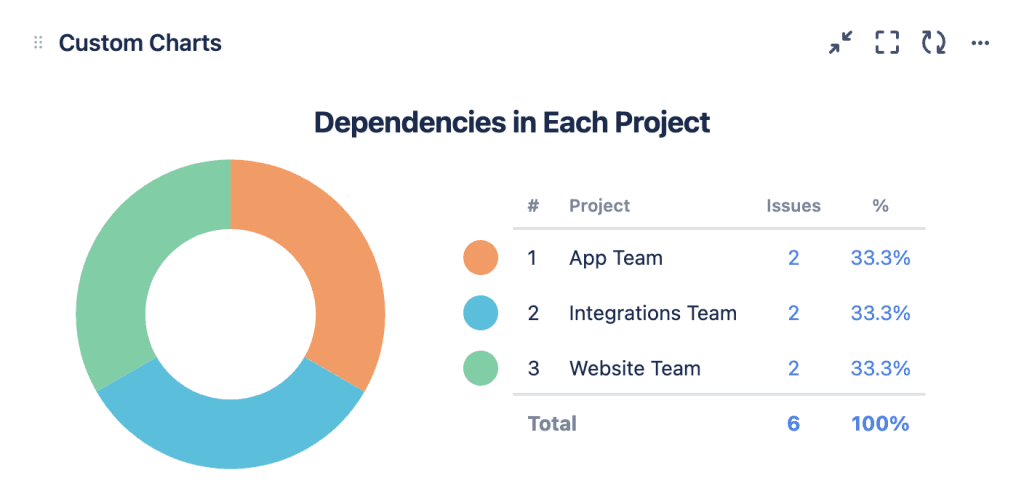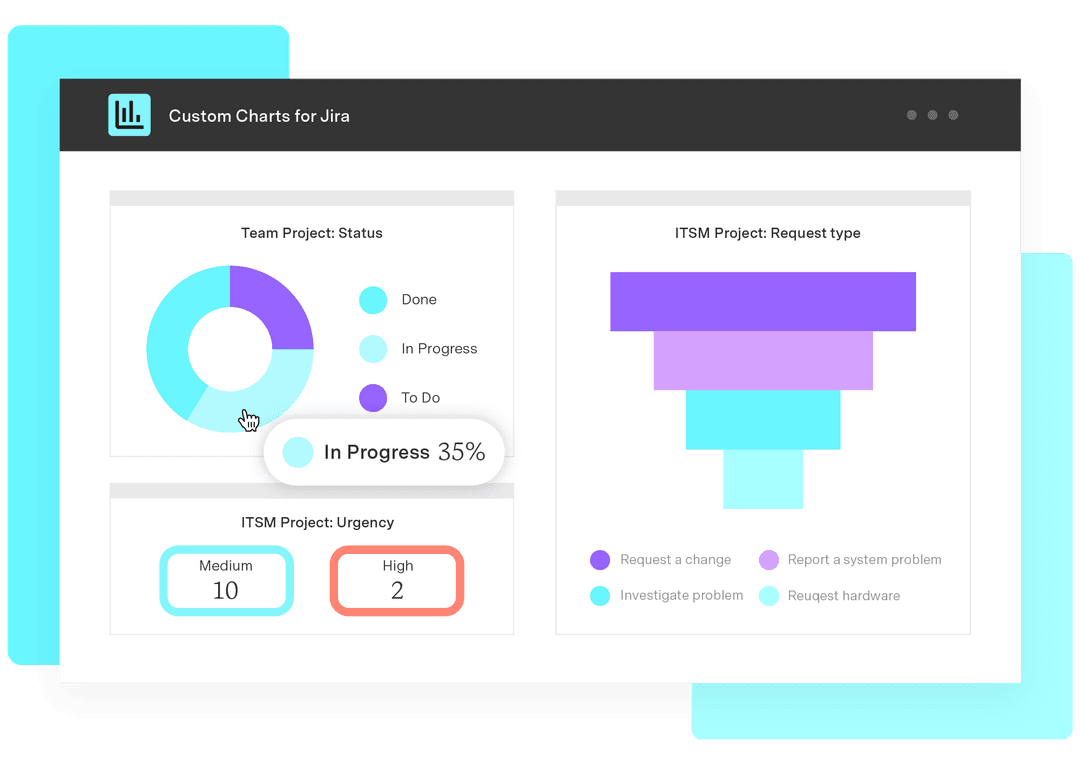What reporting can you do in Advanced Roadmaps for Jira?
Tempo Team
What is Advanced Roadmaps for Jira and why do companies use it?
If your organization has multiple teams working in Jira, there are times when you will want them working together on larger-scale initiatives.
However, it can be difficult to get them aligned when they’re working in their own Jira projects. Things get even more difficult when tasks to be completed by one team are dependent on tasks being completed by another, but you can’t see these dependencies in Jira.
This is where Advanced Roadmaps for Jira comes in rather handy. Advanced Roadmaps allows you to create long-term plans in Jira that tie together the work of different teams into broader initiatives. It offers a visual, customizable overview of the bigger picture that’s particularly useful for enterprise-level managers.
Teams and their managers can see how their work relates to that of other teams and contributes to company-wide goals. It also gives them the visibility to plan work ahead of time and ensure they have enough capacity to complete it.
Designed for up to 20 teams, Advanced Roadmaps is great for scaling up your agile practices. Teams don’t have to be agile, though. Business teams may be using Jira or Jira Work Management in a more waterfall style, which is fine, because Advanced Roadmaps has expanded its features to encompass waterfall and hybrid methodologies (e.g. it has Gantt views!).
Originally known as Portfolio for Jira, Advanced Roadmaps comes with Jira Software Cloud Premium, Jira Software Cloud Enterprise, and Jira Software Data Center.
If your organization has more than 20 teams, particularly ones working in different Jira Cloud instances, the Tempo stack could be a better fit. Tempo offers tools such as Roadmunk, Structure, and Custom Charts that allow organizations to plan and track work beyond the team level and across multiple instances, unlike Advanced Roadmaps, which only works with one instance. This is especially useful for organizations practicing the Scaled Agile Framework (SAFe).
How does Advanced Roadmaps for Jira work?
Advanced Roadmaps facilitates the building and visualization of larger bodies of work. In basic Jira, the epic is the largest body of work you can create, but Advanced Roadmaps lets you build initiatives to house your epics, or uber-initiatives to house your initiatives.
In fact, you can add as many hierarchical levels above an epic as you want. You do this by making new issue types for each level and mapping them to the hierarchy of issues in Advanced Roadmaps.
When your issue types and hierarchy are sorted, you make a “plan” by pulling Jira issues from projects, boards, and saved filters into a customizable timeline format, aka Gantt chart.
What reporting can you do in Advanced Roadmaps?
You’ll need reports to see how your larger bodies of work are progressing, and if all your teams are on track to deliver on the company’s wider goals and vision.
In Advanced Roadmaps, however, the reporting capabilities are limited. There’s a single dependencies report that isn’t customizable in any way, and that’s it. For more insights, you’d need to look to the Atlassian Marketplace and apps like Custom Charts for Jira.
With Custom Charts, you can create your own fully customizable dependencies report directly on the Jira dashboard. Custom Charts’ integration with Advanced Roadmaps lets you build all kinds of other reports using Advanced Roadmaps custom fields. Then you can have program dashboards that are fully tuned to the needs of their viewers, like the one below.

Let’s take a look at each of these reports in turn and explore how they can help Advanced Roadmaps users monitor progress on their plans.
Jira Issues by Parent report

In Jira, the “Parent” field defines the hierarchy of issues. In basic Jira, a story is the parent of its subtasks and an epic is the parent of its stories. In Advanced Roadmaps, the “Parent” field includes any hierarchical level above an epic, e.g. an initiative, which is the parent of an epic. For our plan, we’re tracking four initiatives at the highest level, which contain our epics.
The tile chart above shows us how many epics we have in each of our initiatives. For planning purposes, it’s nice to see that the first initiative, Dev Work, has several issues being worked on. However, we can see that the iOS Platform Update initiative has not been fully planned/thought out yet, as it only has one issue.
You can also color-code the frame on the tile chart to indicate initiative health and what needs attention most urgently, i.e. red for iOS Platform Update, green for Dev Work.
Time Until Target End Date report

Advanced Roadmaps comes with two date fields that can be implemented in Custom Charts for Jira: “Target Start” and “Target End”. If a team is trying to stay on top of deadlines, reports that show how much time is remaining on an epic or initiative is crucial.
In the table chart above, we’re calculating the time until each epic reaches its target end date. As we can see, two epics aren’t far off hitting their end dates. APP-5 in particular has only 5 days left, which means the team should prioritize its work.
If you link this chart to the Simple Search gadget (which comes with Custom Charts), then you can dynamically filter this table chart and display, for example, only issues that have a target end date set for next week.
Status of Milestones report

Your Advanced Roadmaps plan may contain a number of milestones, i.e. a significant stage in the development of a product or project. The Custom Charts product team treats each release as a milestone, as each time we release a new feature or bug fix, it represents an important enhancement of the app.
Visualizing the status of the issues in each milestone helps teams understand whether or not they are on track to release as intended.
In the 2D grouped bar chart above, we’re visualizing releases across several projects featured in our Advanced Roadmaps plan. We’ve set the Source of the chart as “Projects” and selected all the ones in the plan. We’ve then selected “Fix Versions” for the Chart By (as releases are called fix versions in Jira), and “Status” for the Group By.
You can see that the majority of the issues in Milestones 1 and 2 are incomplete, but Milestone 3 is going extremely well. This may mean that the team needs to reallocate resources to make sure the first two milestones can be delivered on time.
Jira Issues in the Program List

You can use Issue List, another gadget that comes with Custom Charts for Jira, to add a list of details pertaining to the Jira issues in your plan to your program dashboard.
To make this chart, we’ve set the Source to be “Projects” and selected the Jira projects that contain the issues in our plan. Then, in addition to the standard Jira system fields, we’ve given three Advanced Roadmaps fields their own columns: “Target Start”, “Target End”, and “Parent”.
Looking at this list, it’s easy to see when we’re planning to have work started and completed by, as well as the larger body of work that houses each smaller item.
We’ve also added a Quick Filter at the top of the list. Quick Filters allow users to drill down into the data on the list. The Quick Filter we’ve made uses a custom Jira Query Language (JQL) statement to only show issues that have a target start date within the coming week, so the team can begin preparing.
You can achieve the same thing by linking Simple Search to Issue List, like we did with the table chart above. However, Quick Filters are unique to Issue List and are a quick and easy way of parsing down data in the gadget itself, without the need for Simple Search.
Dependencies in Each Jira Project report

Dependencies are Jira issues that put the completion of work at risk if not attended to. As mentioned above, although Advanced Roadmaps comes with a dependencies report, you can’t do anything with it. The report displays issues as tiles with arrows illustrating which issues are dependent on others.
While this is good for actually seeing what the issues are, you might want an at-a-glance view of how many dependencies you have (particularly if you have a lot).
Once you create dependencies in Advanced Roadmaps, the Jira issues receive a “blocks” or “is blocked by” link type. You can then make a chart in Custom Charts, like the pie chart above, to show issues with those link types in each project. We’ve set the Source as Advanced (JQL), and written a JQL query to pull in the dependencies. The JQL statement is:
Issuelinktype in (“is blocked by”, blocks)
We’ve then set the Chart by dropdown to be “Project”.
We can see that each project has two issues marked as dependencies. Users can click into the issues to see their details and then prioritize those items if needed.
Conclusion
Advanced Roadmaps for Jira is all about visualizing the bigger picture, specifically, visualizing the collaborations between different teams on company-wide projects.
However, although it is great for visualizing what work is actually happening, it falls down on visualizing progress on that work. To see progress and track whether teams can deliver on your Advanced Roadmaps plans, you need reports. And out-of-the-box reporting with Advanced Roadmaps leaves a lot to be desired.
This is why we built an integration between Custom Charts for Jira and Advanced Roadmaps. It was so teams and managers could visualize progress on their company-wide initiatives, and use those insights to make decisions on their Advanced Roadmaps plans. As a Jira dashboard extension, Custom Charts is a good match for Advanced Roadmaps, because it’s designed to report on the bigger picture, i.e. progress on multiple projects at once.
Put Custom Charts and Advanced Roadmaps together and you have a robust and powerful view of how you’re tracking towards your larger enterprise goals. One that allows you to prioritize tasks, identify bottlenecks, measure risk, and motivate teams more effectively.
Sign up for a demo
Register











































